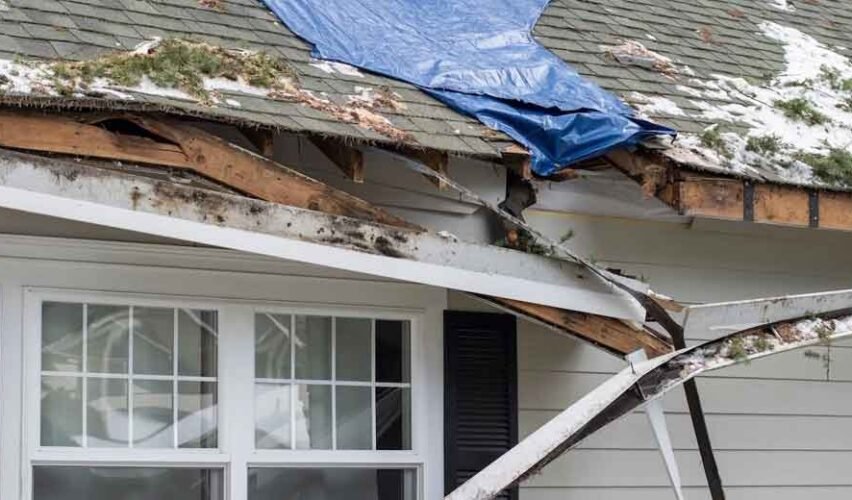Your roof is basically a shield that protects your house from everything the sky throws at it. Rain, snow, wind, and sun all hit your roof first, and different roofing materials handle these challenges in completely different ways. Understanding how weather affects your roof can help you make smart choices about repairs, replacements, and maintenance.
Asphalt Shingles and Weather Changes
Asphalt shingles are the most common roofing material, and there’s a good reason for that. They work pretty well in most weather conditions and don’t cost too much. But they’re not perfect, and weather definitely affects how long they last.
Hot summer sun is probably the biggest enemy of asphalt shingles. The heat makes the shingles expand and contract every day, which eventually causes them to crack and curl. Dark-colored shingles get even hotter than light ones, which means they might wear out faster in really sunny places.
Winter brings different problems. Snow and ice can build up on asphalt shingles, and when it melts and refreezes, it can push under the shingles and cause leaks. The freeze-thaw cycle also makes any small cracks bigger over time.
Wind can be really tough on asphalt shingles too. Strong winds can lift the edges of shingles and even blow them off completely. Once a few shingles are gone, wind and water can get underneath and damage more of the roof.
Rain doesn’t usually hurt asphalt shingles directly, but it can find weak spots. If shingles are already cracked or curled from sun damage, rain can seep through and cause water damage inside your house.
Metal Roofing in Different Climates
Metal roofs are becoming more popular because they handle weather really well. They’re tough and can last a long time, but they still have some weather-related challenges.
Heat doesn’t bother metal roofs much at all. In fact, metal roofs reflect a lot of sunlight, which keeps houses cooler in summer. This can save money on air conditioning bills. Metal expands and contracts with temperature changes, but good installation accounts for this movement.
Snow slides right off most metal roofs, which prevents ice dams from forming. Ice dams happen when snow melts and refreezes at the edge of the roof, creating a barrier that makes water back up under shingles. Metal roofs don’t have this problem because the snow just slides off.
Wind is where metal roofs really shine. They can handle much stronger winds than asphalt shingles. Properly installed metal roofing can survive hurricane-force winds without damage.
Rain sounds louder on metal roofs, but that’s just a noise issue, not a structural problem. Metal doesn’t absorb water, so rain runs off quickly without causing damage.
The main weather challenge for metal roofs is hail. Large hailstones can dent metal roofing, though it usually still works fine even with dents. Some types of metal roofing are more resistant to hail damage than others.
Choosing Materials for Your Climate
Different climates have different weather patterns, so the best roofing material depends on what kind of weather you get. If you need professional advice about what works best in your climate, a Nampa roofing company can help you understand your local weather challenges and recommend the right materials.
Hot, sunny climates are tough on most roofing materials. Metal roofs and tile roofs handle the heat better than asphalt shingles. Light-colored materials reflect more heat than dark ones, which helps with cooling costs.
Cold climates with lots of snow need roofing materials that can handle freeze-thaw cycles and heavy snow loads. Metal roofs work well because snow slides off them. Asphalt shingles can work too if they’re installed properly with good underlayment.
Windy areas need materials that won’t blow off. Metal roofing is usually the best choice for places that get hurricanes or tornadoes. Tile can work well too if it’s properly installed.
Wet climates need materials that dry quickly and don’t absorb water. Metal and tile work well. Wood roofing can be problematic in very wet areas unless it’s treated and maintained carefully.
Clay and Concrete Tiles vs Weather
Clay and concrete tiles are common in warmer climates, especially in the Southwest. They handle some weather conditions really well but can have problems in others.
Hot weather is perfect for tile roofs. They don’t get damaged by heat and sun the way asphalt shingles do. Tiles also provide good insulation, which helps keep houses cool in summer.
The biggest problem with tile roofs is freezing weather. When water gets into small cracks in tiles and then freezes, it expands and can break the tiles. This is why tile roofs aren’t very common in places that get hard freezes.
Wind can be tricky for tile roofs. The tiles themselves are heavy and usually stay put in moderate winds. But really strong winds can lift individual tiles, especially if they weren’t installed perfectly or if the underlayment has gotten old.
Heavy rain usually isn’t a problem for tile roofs because the tiles are designed to shed water quickly. But if individual tiles are cracked or missing, water can get through to the underlayment and cause leaks.
Hail is probably the worst weather for tile roofs. Tiles can crack or break when hit by large hailstones, and broken tiles need to be replaced to prevent leaks.
Wood Shingles and Weather Challenges
Wood shingles and shakes used to be more popular than they are now. They look nice and can last a long time in the right conditions, but they’re pretty sensitive to weather.
Wet weather is the biggest challenge for wood roofing. Wood soaks up moisture, and if it stays wet for too long, it can rot or grow mold and moss. Wood shingles need to dry out completely between rain storms to stay healthy.
Sun can actually help wood roofs by drying them out, but too much sun and heat can make wood shingles crack and split. This creates gaps where water can get in during the next storm.
Wind can lift wood shingles just as it can asphalt ones. Once some shingles are loose or missing, more wind damage usually follows.
Snow and ice create problems for wood roofs because the wood soaks up water when the snow melts. If this happens repeatedly without the wood drying out completely, rot can set in.
Fire is also a concern with wood roofing in dry climates. Many places with high fire risk don’t allow wood roofing materials anymore.
Maintenance Makes a Difference
No matter what kind of roof you have, regular maintenance helps it handle weather better. Keeping gutters clean lets water flow away from the roof properly. Replacing missing or damaged shingles prevents small problems from becoming big ones.
Different materials need different kinds of maintenance. Asphalt shingles might need individual shingles replaced after storms. Metal roofs need their fasteners checked periodically. Tile roofs need broken tiles replaced quickly to prevent leaks.
Weather damage often starts small and gets bigger over time. A small leak can turn into major water damage if it’s not fixed quickly. Regular inspections help catch problems early.
Weather Patterns Are Changing
Weather patterns seem to be getting more extreme in many places. Stronger storms, more hail, and bigger temperature swings mean roofs have to work harder than they used to.
This makes it even more important to choose the right roofing material for your climate and to keep up with maintenance. A roof that might have lasted 20 years in the past might only last 15 years now if the weather is getting more severe.
When you’re choosing roofing materials, think about the worst weather your area gets, not just the average weather. Your roof needs to handle the strongest winds and biggest hailstones, not just normal sunny days.
Making Smart Roofing Decisions
Understanding how weather affects different roofing materials helps you make better decisions about your home. No roofing material is perfect for every climate, but some are definitely better than others for specific weather conditions.
Think about what kind of weather your area gets most often, and what kind of extreme weather happens sometimes. A material that works great most of the time but fails in extreme weather might not be the best choice.
Remember that proper installation and regular maintenance can help any roofing material last longer and handle weather better. Even the best materials won’t work well if they’re not installed correctly or maintained properly.



